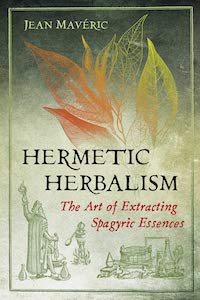
Hermetic Herbalism: The Art of Extracting Spagyric Essences, by Jean Mavéric, edited and translated by R. Bailey
Inner Traditions, 1620559857, 234 pages, May 2020
I was first drawn to Hermetic Herbalism: The Art of Extracting Spagyric Essences by Jean Mavéric (in a new translation by R. Bailey) because of my fascination with the very subject described by the title: the influence of hermetic thought on the history of the use of plants for maintaining health. I thought it would be a practical guide to a little-known form of herbalism that has recently gained in popularity, and that I would learn how to make spagyric essences. I had no idea that, in addition to a hermetic guide to plant preparations, I would be getting a fascinating compendium of herbal lore, with lists of properties, correspondences, and suggested remedies, from the theory of the humors to the plants and the planets.
Clearly a product of the 19th century’s renewed interest in all things magical, and the desire of scholars of that time to be as complete and scientific as possible, the book, originally published in French in 1911, feels at first like an arcane encyclopedia. A concise foreword by the translator paves the way for understanding just where the author, in all his own mystery, was coming from. As we start to read, we can picture the mysterious Jean Mavéric in his garret, surrounded by old books. Yet the author explains that the book is not a “mere compilation,” but there for the reader to extract its “quintessence.”1
Reading it is its own alchemical process, and the author guides the reader well from the beginning of this voyage. Hermetic Herbalism thus does more than supply a summary of its subject matter; it offers a glimpse of the magical revival of the 19th century and how writers of the time sought to preserve and share esoteric knowledge, transmitted in premodern times by Paracelsus and his followers.
A basic knowledge of hermeticism and astrology comes in handy for a reader starting to travel with Mavéric, yet like any good French scholar, he begins with a discussion of the terms he will be using, so newer scholars of the hermetic arts are not left too far behind. As he separates the subject matter into short, digestible chapters, the reader can also perceive how the elements, the planets, the humors and the plants interconnect, leading up to an understanding of astrological herbalism and how to read a natal chart.
Mavéric details how to map the planets onto the body according to hermetic correspondences, offering some questions for the student of astrology to ponder. I really appreciated the detail to be found here, including the relationships between the planets, the elements, the humors and the body’s functions. I better understand, for example, why my capacity to act can sometimes feel blocked since Mars lives in the sixth house in my natal chart, one of the houses that Mavéric says most influences our vitality. I feel that I know the planets better and can thus better assess how I am feeling their influence at any given time.
His discussion of the houses also clarified the relationships of each one to the others and also the whole. Not all of his explanations on how to analyze a natal chart were clear to me, and I found myself thinking that I would want to follow up with a teacher on how, for example, to locate the astrological sign that represents the head in someone’s natal chart. Beware, it isn’t always Aries! Finding someone’s “astral temperament”2 also requires a more complex set of calculations than I could figure out, but I know I can return to these finer points after further study.
Part two deals with the more practical matters of premodern herbalism: the fires, vessels, and processes required to extract the “juices” and salts of plants according to class. Reading it, I wondered if I would ever be able to try any of these preparations. My conclusion was that I would definitely need a mentor — too bad I can’t visit Mavéric in his laboratory. Plus, all of the preparations take time — thirty or forty days, the “philosophical month.”3
I wish I had gotten the book a little earlier, during lockdown, when I really would have had the time to digest it, and that I knew where to order an alembic. But whether you are reading the book for practical application or theoretical investigation, Marvéric supplies you with the raw material to engage in the beginnings of your own mental fermentation on the topic. In the meantime, I’m dreaming of distilling rainwater and dissolving salts, wondering how this all may be a metaphor for my own evolution.
In conclusion, I think Hermetic Herbalism will be a useful companion during my study of both herbs and astrology, allowing me to deepen how I understand the interaction between the two. The astrological calculations described are quite complex, but give me something to look forward to as I continue my reading of the stars and the planets in relation to the Earth. All I need is some more “practice, patience and perspicacity”!4 I look forward to further translations of esoteric French works from this period by R. Bailey, who combines careful and clear translations with in-depth notes and references on the author’s sources that the original work lacks. The indexes (of common plant names, scientific plant names, authors, and subjects) and bibliography will make this book an important volume in my herbal library.

Amy Heneveld is a medievalist, writer and scholar living in Northern Vermont. She has a flower essence making and coaching business called Enosburgh Essences with which she guides people to connect more deeply to their creative essence through plant communication (www.enosburghessences.com). Fascinated by the hermeticism and the esoteric knowledge of plants, when she isn’t teaching French in two local high schools she can be found translating for the flowers and connecting to the cosmos.
